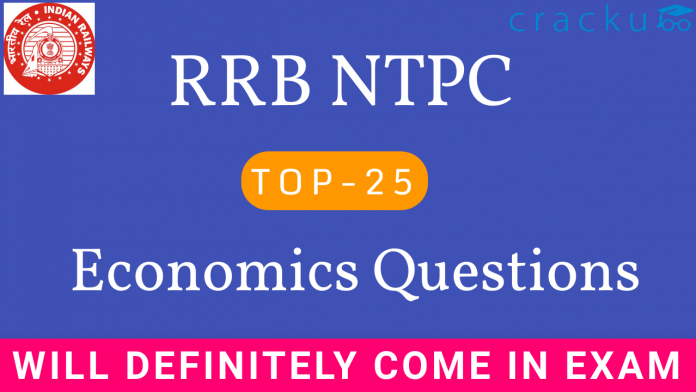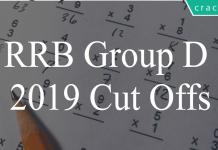Top-25 RRB NTPC Economics Questions PDF
Download Top-25 Important Economics Questions for RRB NTPC exam. Go through the video of Repeatedly asked and most important RRB NTPC Economics questions with answers. These questions are based on previous year questions in Railways and other Govt exams.
Download RRB NTPC Economics Questions PDF
Practice:
Take a free mock test for RRB NTPC
Practice 4500+ Solved Questions for RRB NTPC
Download:
Download RRB NTPC Previous Papers PDF
Download RRB NTPC Study Material PDF
Read this Post in Telugu
Question 1: Stagflation is a period of .
a) Persistent high inflation combined with high unemployment
b) Persistent high inflation combined with low unemployment
c) Persistent low inflation combined with high unemployment
d) Persistent low inflation combined with low unemployment
Question 2: Secular Stagnation refers to
a) A stagnant economy
b) Recurring booms and depressions in the economy
c) Decrease in the marginal Growth rate
d) Fluctuations in the Autonomous Investment
Question 3: The _________ of a firm is a relationship between inputs used and output produced by the firm.
a) Marginal product
b) Production function
c) Total product
d) Average product
Question 4: Who are the main bearers of the burden of the Indirect tax ?
a) Manufactures
b) Traders
c) Consumers
d) Tax Payers
Question 5: The major aim of the devaluation is to ?
a) Encourage imports
b) Encourage Exports
c) Encourage both Imports and Exports
d) Discourage both the exports and imports
Question 6: Goods whose demand is proportional to price are called
a) inferior goods
b) Veblen goods
c) normal goods
d) exclusive goods
Question 7: An increase in price will _________.
a) increase consumer surplus
b) decrease consumer surplus
c) have no affect on consumer surplus
d) decrease producer surplus
Question 8: The long term fiscal policy proposes to maintain the stability of which quantity?
a) Direct Tax
b) Ratio of tax to Income
c) Ratio of tax revenue to national income
d) Indirect Tax rates
Question 9: Inflation exists when
a) there is general increase in the prices over time.
b) there are periodic decreases in the price level.
c) there are continuous increases in the output level over time.
d) there is rise in the purchasing value of money.
Question 10: The basic Regulatory of the Mutual Funds and stock markets in India ?
a) Government of India
b) R.B.I
c) SEBI
d) Stock Exchange
RRB NTPC Previous Papers [Download PDF]
RRB NTPC Study Material – 4500+ Questions
Question 11: The Law of Demand is based on the concept that people .
a) buy more of a good as their income increases.
b) buy more of a good as the price of the good falls.
c) will spend all of their money on something.
d) want more of everything even if they have no money to buy anything.
Question 12: Consumer sovereignty means
a) Consumers are free to spend their income as they like
b) Consumers have power to control The economy
c) The power of consumers to determine what goods and services are produced
d) Consumers goods are free from government control
Question 13: An increase of 1% per annum in the rate of growth of the money supply will increase inflation in the long run by .
a) Zero percent
b) One percent
c) 0.5 percent
d) More than one percent
Question 14: Interest on public debts is a part of the ?
a) Transfer Payments by the enterprises
b) Transfer payments by the Government
c) National Income
d) Interest Payments by the households
Question 15: Increase in the demand for a good will cause the equilibrium price of the good to ………….and the equilibrium quantity to …………..
a) increase; increase
b) decrease; decrease
c) increase; decrease
d) decrease; increase
Question 16: Lowering of value of currency relative to a foreign reference currency is called ……………….
a) Devaluation
b) Revaluation
c) Down valuation
d) Negative valuation
Question 17: Investment and savings are kept equal through a charge in the level of ?
a) Consumption
b) Investment
c) Government Expenditure
d) Income
Question 18: The goods which people consume more, when their price rises are called _______.
a) Essential goods
b) Capital goods
c) Veblen goods
d) Giffen goods
Question 19: In perfect competition ……………
a) Products can be similar or different
b) Producer can control price by controlling production
c) Demand curve is perfectly elastic
d) All firms make economic profit in the long run
Question 20: If cash reserve ratio decreases, credit creation will _______.
a) increase
b) decrease
c) does not change
d) first decreases than increases
Daily Free RRB Online Tests for RRB Exams
Question 21: The market for sugar is in equilibrium. If the supply of sugar increases, the equilibrium price of sugar will ………………and the equilibrium quantity will ……………….
a) increase; increase
b) decrease; decrease
c) increase; decrease
d) decrease; increase
Question 22: Macro economics deals with
a) the circular flow of income
b) the decision making of a single economic variable like demand
c) resource allocation at firm level
d) equilibrium prices and quantities
Question 23: The demand curve …………..
a) shows that as the price of a good increases, demand for the good will increase
b) shows that as the price of a good increases, demand for the good will decrease
c) has a positive gradient
d) indicates that there is a direct relationship between quantity demanded and price
Question 24: A minimum wage _____.
a) is the price floor below which workers may not sell their labor
b) is set at a price below the equilibrium wage
c) creates a price ceiling below which the wage cannot legally go
d) decreases unemployment
Question 25: The SLR is determined by the RBI. SLR stands for
a) States Leverage Return
b) Savings Lease Rate
c) Statutory Liquidity Ratio
d) Safe Legal Range
Answers & Solutions:
1) Answer (A)
2) Answer (B)
3) Answer (B)
4) Answer (C)
5) Answer (B)
6) Answer (B)
7) Answer (B)
8) Answer (B)
9) Answer (A)
10) Answer (C)
11) Answer (B)
12) Answer (C)
13) Answer (B)
14) Answer (B)
15) Answer (A)
16) Answer (A)
17) Answer (A)
18) Answer (D)
19) Answer (C)
20) Answer (A)
21) Answer (D)
22) Answer (A)
23) Answer (B)
24) Answer (A)
25) Answer (C)
Download RRB NTPC Previous Papers PDF
DOWNLOAD APP FOR RRB FREE MOCKS
We hope this very important RRB NTPC Physics Problems will be very helpful to you.





